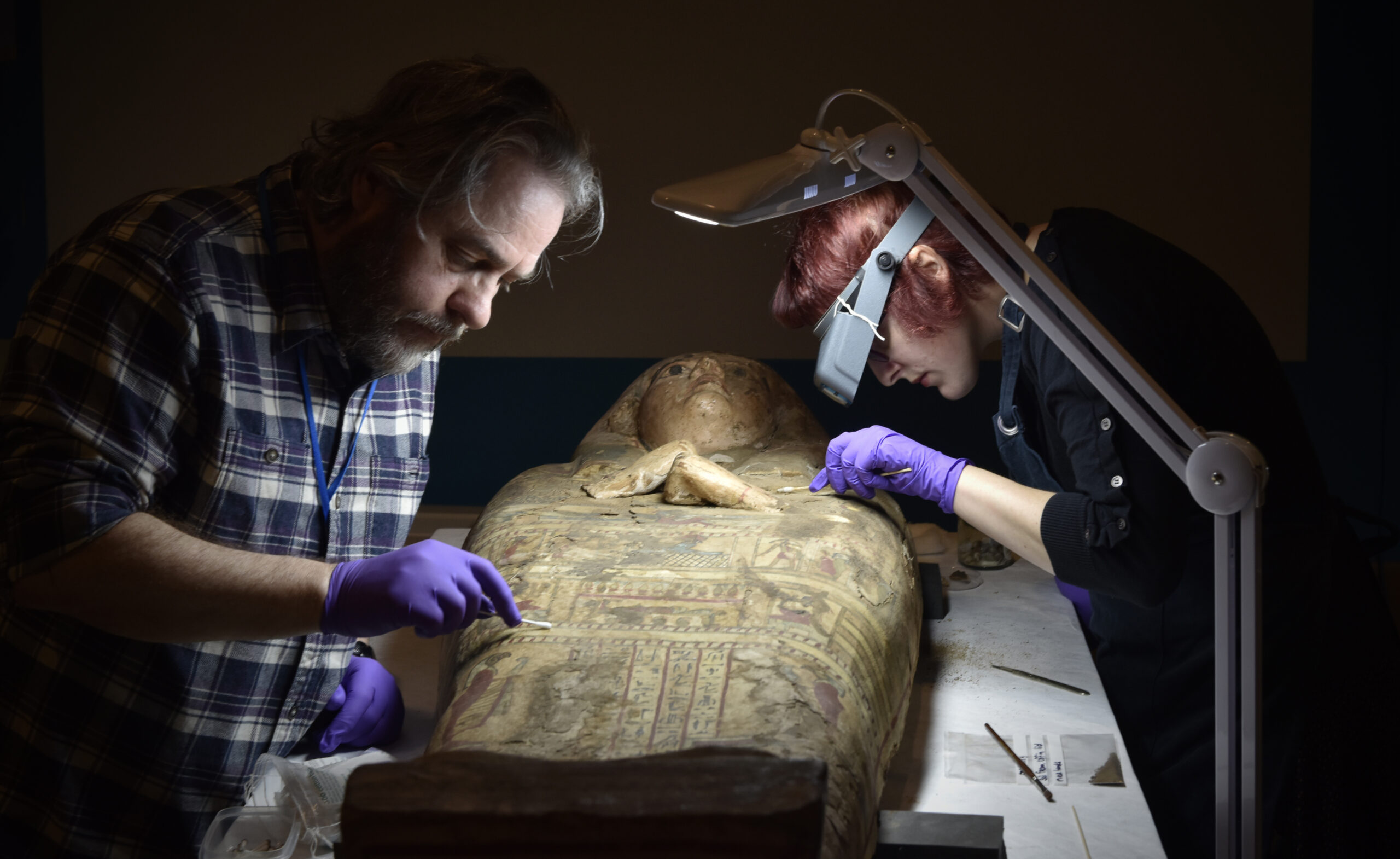Enter a search term above to search our website
Pages
News
Star Objects
In this blog for Perth Museum, Dr Mark Hall writes about the facial reconstruction work that has been carried out in partnership with Dr Chris Rynn.
As part of Perth Museum’s new temporary exhibition, Waters Rising, we are delighted to unveil a new digital facial reconstruction of the ancient Egyptian body we look after, and whose name may have been Ta-Kr-Hb. This blog gives a brief account of the background to the reconstruction and also to the context in which the body came to Perth and the alternative to labelling her a ‘Mummy’.

Dr Mark Hall and Anna Zwagerman carefully clean the sarcophagus of Ta-Kr-Hb. Photographed by Julie Howden
The facial reconstruction and its animation were carried out for us by Chris Rynn, a leading cranio-facial anthropologist. Using the results of a previous phase of analysis, including CT-scans and X-rays carried out in Manchester, Chris successfully created what the young woman’s face most likely looked like. She has the typical features of a Kushite woman. The kingdom of Kush operated over much of Sudan and often in rivalry with its immediate northern neighbour Egypt. For several centuries the Kushites conquered and ruled over Egypt, providing a line of Black Pharaohs in the middle of the first millennium BCE. As admirers of Egyptian culture, the Kush re-used and reimagined much of it. TaKrHb’ s sarcophagus may be an example of such reuse.
Because of the woman’s burial in a sarcophagus, we have made the assumption that she was likely to have been someone of status, which is why we have also shown her with a shaven head. Members of the elite, especially priests and priestesses, shaved their heads as a gesture that put them nearer to the Gods and as a matter of hygiene. Stylistically, the coffin probably comes from Akhmim, in Upper Egypt. The coffin has gone through at least one episode of flooding (by the Nile) and grave-robbing, in ancient times. As a result, we cannot be absolutely sure that she is the TaKrHb named in the hieroglyphic inscription on her coffin lid. When priests encountered coffins and bodies that had been separated because of flooding and/or grave-robbing they would be anxious to try and counter such disturbance and would rewrap any body and place it in any available coffin. The body and coffin were taken from Akhmim in the 19th century and moved to Cairo. There, in the 1890s they were acquired by an Alloa businessman who donated them to his hometown. The Museum that housed the remains was closed in 1936 and the sarcophagus and body were passed to the former Perth Museum & Art Gallery. This is now know as Perth Art Gallery, with the social and natural history collections being displayed in the new Perth Museum.

Ta-Kr-Hb with Anna Zwagerman. Courtesy of Culture Perth & Kinross.
It has been a commonplace to refer to such preserved bodies as ‘Mummies’ since the 19th century. The word is an adaptation of the Arabic word Mumia, meaning bitumen/mummified person, itself taken from a Persian word. The bitumen referred to is the black resin often used to coat the preserved bodies. The ancient Egyptians did not call their deceased Mumia. They used the terms Sah and Sahw respectively, for an individual and for more than one. The term encompassed the preserved body, its wrappings, any amulets, mask, foot covering, cartonnage and coffins. This assemblage represented the new homes for the semi-divine spirits of the deceased. Often the sarcophagi or coffins containing all this material would be set upright as cult statues, to be revered and prayed too. Through death they became beyond human.
Ta-Kr-Hb’s sarcophagus and facial reconstruction are on display now in the Waters Rising exhibition until 16 March 2025. Book your tickets here.